#lincoln assassination 1865
Explore tagged Tumblr posts
Text
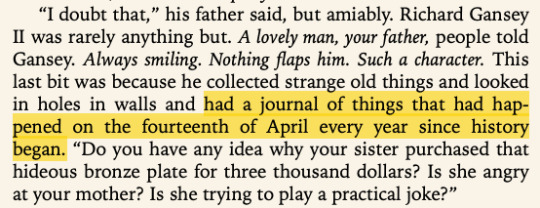
very important day for richard gansey ii apparently
#rchl#trc#the following happened on april 14th:#lincoln assassination 1865#mt vesuvius eruption 1906#john singer sargent death 1925#titanic iceberg collision 1912#amongst many other events listed in a wikipedia page i just spent 10 minutes staring at#mt vesuvius and sargent's death are not in that article but i had them written down in my chapter notes
399 notes
·
View notes
Text
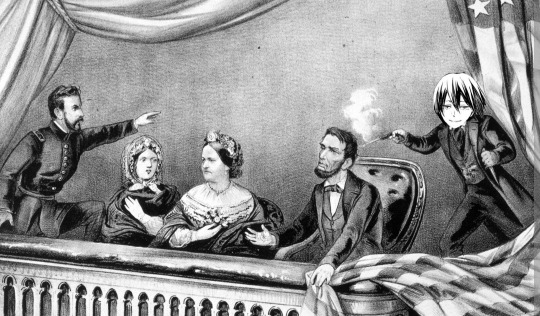
Fyodor Dostoevsky at Abraham Lincolns assassination, April 15, 1865!
403 notes
·
View notes
Text
dean walks into the war room one day to see what seems like jack and cas glitching in and out of the bunker while they point to different parts of the map table and dean is like guys what the fuck and cas is like i'm showing sam and jack my favorite points in world history and dean is like uhhh i don't see sam??? and jack is like oh yeah we left him at the petersen house in 1865 he really wanted to watch a play there for some reason and dean on a verge of a heart attack turns to cas like you took sam on a field trip to watch lincoln get assassinated???? and cas just deadpans no i left him there he wanted to take pictures
1K notes
·
View notes
Text
"Thank you Mr. President" Jackie Kennedy's letter to LBJ less than 24 hours after burying JFK
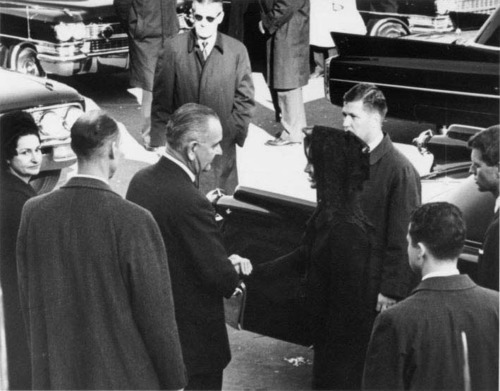
When Lyndon Baines Johnson was sworn in as President on board Air Force One at Love Field in Dallas, Texas on November 22, 1963, Jackie Kennedy was standing next to him, her pink Chanel dress, white gloves, and bare legs smeared with the blood and brain matter of her assassinated husband. Traumatized and almost certainly in shock, Jackie wanted to support the new President and new First Lady as power was officially transferred in the same solemn ceremony that has always marked such an occasion in American History. As the Presidential airplane left Dallas and returned to the nation's capital, Jackie sat in the back of the plane with the coffin containing her husband's body.
Despite her deep personal loss, her traumatic experience, and her obvious physical exhaustion, Jackie threw herself into planning President Kennedy's funeral as soon as she returned to Washington, D.C. Jackie was sensitive to the needs of the country and protective of her husband's legacy. When she arrived at the White House, she requested information about the exact specifications of Abraham Lincoln's funeral after he was assassinated in 1865. Even though it was the middle of the night, Kennedy staffers went to the National Archives and the Library of Congress to research the Lincoln funeral and Jackie helped make plans for the pageantry that would commence over the next few days. With a few minor exceptions, JFK's funeral was nearly an exact replica of Lincoln's funeral almost 100 years earlier. The effect was monumental. Kennedy's funeral will always be remembered as a dignified, iconic moment in our nation's history.
As Jackie Kennedy prepared to bury the 35th President, Lyndon Johnson consumed himself with becoming the 36th President, continuing Kennedy's work and leading the nation through the darkness of the assassination and its aftermath. When Air Force One landed at Andrews Air Force Base on the night of November 22nd, the Secret Service urged now-President Johnson to take a helicopter directly to the White House. Johnson immediately vetoed the move as he thought it would disrespectful for him to land on the South Lawn of the White House (as Presidents regularly do) while Kennedy's family still lived in the building. When LBJ arrived at the White House via motorcade to begin his work that night, the new President went directly to an office in the Old Executive Office Building rather than working out of the Oval Office.
Over the next few weeks, President Johnson extended many kindnesses to Jackie Kennedy. LBJ and Jackie had always had an extremely close relationship, and Johnson never forgot how kind Jackie had been when LBJ was Vice President -- a depressing time for Johnson due to his lack of power and influence. During his Vice Presidency, Johnson had experienced many problems with members of Kennedy's Administration, but was always treated very well by President and Mrs. Kennedy.
The Kennedys had two young children who had just lost their father, and the first thing that LBJ did as President was write two letters to President Kennedy's children to read when they were old enough to understand them. When JFK was elected President, the Kennedys hoped that their daughter Caroline would be able to attend a normal school with children her age. When it became apparent that the logistics wouldn't allow that, a room was prepared at the White House for Caroline's teacher to hold class daily. When JFK was assassinated, LBJ insisted that Caroline's class continue using the White House for classes as long as Jackie wished. In fact, LBJ urged Jackie to continue living in the White House throughout the entirety of his term. Jackie moved out within a few weeks, but she appreciated President Johnson's offer.
What Jackie Kennedy most appreciated, however, was President Johnson's presence at John F. Kennedy's funeral. On November 25, 1963, the entire nation stopped and world leaders gathered in Washington to bury the slain President (one place that the nation didn't stop was Dallas, where JFK's assassin Lee Harvey Oswald was shot and killed as he was being transferred to another police facility). Kennedy's funeral was historic and emotional. The enduring image is of John F. Kennedy, Jr. -- celebrating his 3rd birthday on that very day -- stepping forward to salute as father's flag-draped casket passed by.
Another stirring image from that day was accompanying President Kennedy's funeral cortége. As Kennedy's casket rested on the exact same caisson that carried Abraham Lincoln's casket, a remarkable procession of some of the most famous, powerful people in the world followed behind it. Led by Jackie Kennedy and the slain Presidents two brothers, Robert F. Kennedy and Edward Kennedy, scores and scores of political leaders, diplomats, monarchs, and more trailed the casket, marching in complete silence other than the sounds of their feet on the pavement. Dozens upon dozens of countries were represented -- not just by ambassadors or minor officials, but by Kings, Queens, Emperors, Presidents, and Prime Ministers. When one looks at the photos, our eyes are immediately drawn to the majestic strength of Jackie Kennedy leading the procession. If the faces of those behind her are scanned, they reveal legendary leaders such as Charles de Galle, Haile Selassie, U Thant, Golda Meier, King Baudoiun I, Lester Pearson, Willy Brandt, Queen Frederica, Eamon de Valera, Prince Philip, Sir Alec Douglas-Home, and scores of other international figures, not to mention the leading Americans, who took to the streets of Washington, D.C. -- on foot -- to honor President Kennedy.
It's often forgotten that Lyndon Johnson was there. Johnson was such a larger-than-life character and so rarely relegated to the background that it's difficult to imagine a scene where he would not be the major player. Since President Kennedy had been murdered in broad daylight on the streets of a major American city just three days earlier, the Secret Service -- understandably nervous due to their failure to protect one President that week -- was adamantly opposed to President Johnson's participation. Johnson overruled the Secret Service concerns and turned down their insistence that he ride in an armor-plated limousine. For maybe the only time in his life, Lyndon Johnson -- now President of the United States -- went virtually unnoticed to the public.
Yet, one person did notice. And, on November 26, 1963, despite all that she had been through; despite all that she was feeling; despite all that she had lost; despite the fact that just 24 hours earlier she had buried her husband, the father of her two young children, the 34-year-old widowed former First Lady Jacqueline Bouvier Kennedy sat down in the White House and wrote this letter to the new President of the United States, Lyndon Baines Johnson:
November 26 Tuesday Dear Mr. President, Thank you for walking yesterday - behind Jack. You did not have to do that - I am sure many people forbid you to take such a risk - but you did it anyway. Thank you for your letters to my children. What those letters will mean to them later - you can imagine. The touching thing is, they have always loved you so much, they were most moved to have a letter from you now. And most of all, Mr. President, thank you for the way you have always treated me - the way you and Lady Bird have always been to me - before, when Jack was alive, and now as President. I think the relationship of the Presidential and Vice-Presidential families could be a rather strained one. From the history I have been reading ever since I came to the White House, I gather it often was in the past. But you were Jack's right arm - and I always thought the greatest act of a gentleman that I had seen on this earth - was how you - the Majority Leader when he came to the Senate as just another little freshman who looked up to you and took orders from you, could then serve as Vice President to a man who had served under you and been taught by you. But more than that we were friends, all four of us. All you did for me as a friend and the happy times we had. I always thought way before the nomination that Lady Bird should be First Lady - but I don't need to tell you here what I think of her qualities - her extraordinary grace of character - her willingness to assume ever burden - She assumed so many for me and I love her very much - and I love your two daughters - Lynda Bird most because I know her the best - and we first met when neither of us could get a seat to hear President Eisenhower's State of the Union message, and someone found us a place on one of the steps on the aisle where we sat together. If we had known then what our relationship would be now. It was so strange - last night I was wandering through this house. There in the Treaty Room is your chandelier, and I had framed - the page we all signed - you - Senator Dirksen and Mike Mansfield - underneath I had written "The day the Vice President brought the East Room chandelier back from the Capitol." Then in the library I showed Bobby the Lincoln Record book you gave - you see all you gave - and now you are called on to give so much more. Your office - you are the first President to sit in it as it looks today. Jack always wanted a red rug - and I had curtains designed for it that I thought were as dignified as they should be for a President's office. Late last night a moving man asked me if I wanted Jack's ship pictures left on the wall for you (They were clearing the office to make room for you) - I said no because I remembered all the fun Jack had those first days hanging pictures of things he loved, setting out his collection of whales teeth etc. But of course they are there only waiting for you to ask for them if the walls look too bare. I thought you would want to put things from Texas in it - I pictured some gleaming longhorns - I hope you put them somewhere. It mustn't be very much help to you your first day in office - to hear children on the lawn at recess. It is just one more example of your kindness that you let them stay - I promise - they will soon be gone - Thank you Mr. President Respectfully Jackie
At the LBJ Library on the campus of the University of Texas in Austin, there are many displays of priceless, historic artifacts that tell the story of the years of Lyndon Johnson, his service to the United States, and the world that he knew. As you pass through the exhibits, it's difficult not to be astonished, inspired, and touched by what you see around you during your visit. Many of the things you'll see there will take your breath away, but nothing leaves an impression on your heart and soul like the seven pieces of paper containing these words in Jackie Kennedy's handwriting -- words that somehow convey strength and fragility, evoke optimism and sadness, and simultaneously project support while demonstrating a sense of loss that very few of us can imagine. Items like these are the source materials for what history truly is -- a biography of humanity, a story about people.
#History#JFK Assassination#Kennedy Assassination#Assassination of John F. Kennedy#JFK#John F. Kennedy#President Kennedy#Jacqueline Kennedy#Jackie Kennedy#First Lady#First Families#Death and State Funeral of John F. Kennedy#Funeral of John F. Kennedy#Presidents#Presidential History#Presidential Funerals#Presidential Deaths#Lyndon B. Johnson#LBJ#President Johnson#White House#Kennedy Family#Presidential Relationships#Presidential Correspondence#JFK's Funeral#60th Anniversary of JFK's Assassination#60th Anniversary#60th Anniversary of the Kennedy Assassination
164 notes
·
View notes
Text
🌿 Herb Of The Day

Title: Lilac
Gender: Feminine
Element: Water
Planet: Venus
���� Folklore & History 📜
Lilacs are an old, old, species that originated in Persia and then traveled to Europe. They were brought to America in 1750 and then planted at New Jersey Governor Wentworth’s home. Other prominent men fell in love with lilacs. They were reportedly one of Thomas Jefferson’s favorite flowers, and he documented his lilac-planting-methods in 1767. George Washington followed suit and moved existing lilacs on his property to his garden in 1785.
In Greek mythology, Pan, the god of the wild, chased a nymph named Syringa. She turned herself into a lilac bush to escape Pan, and in anger, he broke off the reed-like branches which made pipes. With regret, he tried kissing the broken branches, and as his air pushed over them, sounds were made. Lilacs were responsible for the creation of “Panpipes.”
Russian folklore believed that hanging lilacs above a baby’s bed would bring the child wisdom.
American folklore thought that lilacs could drive away evil and that placing them in a haunted house would displace ghosts. Thought to be symbolic of “old love,” Victorian widows often wore lilacs as a sign of remembrance. One hundred and fifty-five years ago today, April 15th, Abraham Lincoln died after being shot by John Wilkes Booth. Any American — and much of the world — knows the story of the self-educated, country lawyer who became one of our nation’s most beloved presidents. But what many Americans might not realize is how the death of Lincoln reverberated into so many areas of our collective psyche, including literature and horticulture, thanks to Walt Whitman. Walt Whitman was a reporter, printer, writer, traveler and Civil War nurse who is considered one of America’s greatest poets. He self-published Leaves of Grass and worked on it throughout his lifetime, eventually modifying it so that there are eight different editions. Whitman felt a great affinity with President Abraham Lincoln, and when Lincoln was assassinated in the spring of 1865, Whitman grieved.
He wrote years later in Specimen Days about learning of the President’s death:
"I remember where I was stopping at the time, the season being advanced, there were many lilacs in full bloom. By one of those caprices that enter and give tinge to events without being at all a part of them, I find myself always reminded of great tragedy of that day by the sight and odor of these blossoms. It never fails."
While lilacs are first to bloom, their flowers are short-lived. The heady fragrance lingers sweetly at first, but then the blooms start to die, leaving a heavy, cloying smell. One of the first flowers of spring, lilacs contain a natural compound called indole that’s found in flowers — and feces. It’s that undercurrent of the “bottom note” of fragrance that suggests decay and death.

🔮 Metaphysical Properties 🔮
The beautiful May-blooming lilac is one of the loveliest tokens of spring. But they are much more than beautiful shrubs with showy, sweet-smelling flowers. Originally lilacs were planted to repel all evil. Planted near the entryway, lilacs were believed to send out protective vibrations. When the flowers are cut and brought into the home they cleanse any living space. And they'll also remove any unwanted spiritual presence. Blue and white varieties work well for this purpose. Since lilacs are ruled by Venus, they are also used in love spells. Try placing some pink lilacs on your altar while performing a love spell. The dried flowers make a powerful addition to any love sachet.

🍴⚕️ Culinary & Medicinal Properties
The simplest way to enjoy lilacs is as an infusion of the flowers for a lilac sugar. The sugar can then be used in recipes to add lilac flavor to baked goods. This also works with a lilac simple syrup which is just a liquid form of the same thing that’s perfect for making cocktails. For my money though, I think lilac infused honey sounds the best. The sweet floral flavor of lilacs translates beautifully into an ice cream base.
To prevent the recurrence of disease, lilac flowers were used to help strengthen the system and prevent relapse after a patient had healed. They’re said to be specifically good after cases of malaria. Tasting the raw flowers you can actually pick up some of the astringent qualities, as they make your mouth dry and pucker a bit (along with their floral flavors). This astringent quality makes them good for use in skin care products. Lilacs are used as a folk remedy for intestinal worms, as well as a treatment for gastric discomfort and gas. Regardless of the purpose, the most likely medicinal lilac preparation is a tincture, which is just a lilac infused alcohol
#elder witch#baby witch#beginner witch#dark witchcraft#herbalism#herbology#herbs#whimsigoth#witch aesthetic#witch herbs#divination#spirituality#spiritual#witchblr#witchcore#witchcraft#witch tip
477 notes
·
View notes
Text
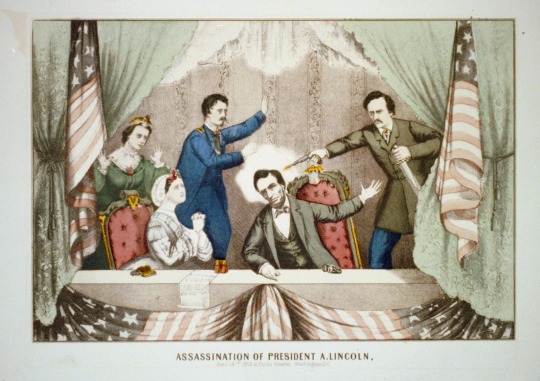
President Abraham Lincoln was shot at Ford’s Theatre in Washington, D.C. on April 14, 1865. The assassin, actor John Wilkes Booth, shouted, “Sic semper tyrannis! (Ever thus to tyrants!) The South is avenged.” Lincoln died the next morning. #OnThisDay
44 notes
·
View notes
Text
About The Recent Election
I know that considering the scale of the loss to the demagogue a lot of Americans are likely demoralized and feeling as if the tides will never shift, as if this will be the state of things forever. I just want to post a reminder, for whatever little number that sees this, that no political shift is forever.
In 1865 Abraham Lincoln was assassinated, his vice-president a pro-Southern Democrat succeeded him, he would proceed to attempt to sabotage reconstruction. Before 1860 the old Democrats had held power for lengthy periods of time. But the following elections, and many since up until 1912, led to Republican presidents being elected.
At the time, the Republicans were the progressive party as they were dominated by their liberal wing, despite intense conservative backlash, even to violence, they still held out and pushed many important reforms, despite some failings. Nowadays, their successor is the modern Democratic Party that has shed its negative elements, by and large, and promotes egalitarian policies.
Its important to remember this example from American history. The march of American history, and global history, is towards progress and democracy. What we see right now is a very worrying interruption but also I want people to remember that the US has had these reactionary backlash periods before.. but the world and US have risen above these impulses to greater popular participation, civil rights, and tolerance. I understand the fear of the next four years, but I also want to remind people that the march of history will continue, that soon enough things will get better again.
What we see now has many antecedents in American history, and global history, but liberal, radical, impulses won out then and led to a less cruel world. They will win out now and lead to a better world.
This isn't the be-all end-all of anything. They cannot take away who you are. We will win and we will create a better world free of the evils of today, no matter what comes next for the next four years.
#politics#election 2024#us elections#presidential elections#uspol#american politics#usa politics#2024 elections#kidneys are a privilege not a human right#drunkposting#im drunk#drunk#drinking#ramblings
13 notes
·
View notes
Note
is abe lincoln the king of mars or does he just coincidentally look like that
That is debateable. If I recall correctly, he's never actually referred to as Abraham Lincoln in the show, and always as King of Mars. But I've always imagined there's some weird time travel stuff happening. The fact we hear a gunshot after his second death in Sons of Mars makes me think he was spirited away to become King of Mars in the moment of his assassination and then got sent back to 1865 again after he sacrificed himself to save Jake.
21 notes
·
View notes
Note
Hello! I invented the ultimate time machine! But it has some problems, it can go back in time as far as you want, or to the future.
BUT! if you try to go between 1880-1939 it won't allow you. Same if you want to travel to recent eras, 1995-2023.
Call your favourite character, oc/ship and travel with them across the time (except the aforementioned years.) Let me know where you landed!
You can create a moodboard or only tell me, where you are ❤️.
Just press the button.

Flor I absolutely LOVE this idea!! 🤩🤩 however….
I feel a bit guilty for abusing (?) it for my own interests…….😬😬
So I’ve recently watched the series Manhunt on Apple TV+ (it’s amazing, everyone should check it out if you haven’t) and that time period in American history/the assassination of Abraham Lincoln and the entire plot of doing so has been on my mind since I finished watching it.
Thankfully the time machine will allow me to go back to America in April of 1865 (Washington DC if I get to pick a place) becuase I’d just love to be amidst the chaos that occurred then and just experience it as it happened. And can I maybe also be on the hunt to capture JWB and the other conspirators??
As for who I’m bringing with me, well there’s where I’m abusing the time machine — I’m not sure if there’s any character/oc/ship that would want to join me in my travelling to 1865 America 😅 … but, if I need to have a buddy in this machine in order for it to work, could you be so inclined to pick someone to join me?
I’m sorry I maybe didn’t answer this in the way you’d hoped it’d be answered, but let me tell you that thinking about it made my history lover’s heart so happy! 😁
…and this was a pretty long-winded response 😅 sorry bout that … BUT I did create a bit of a moodboard for it too, so that’s below the cut.
Thanks for sending this my way Flor! 💛

7 notes
·
View notes
Text
After an academic discussion about the ramifications of trying to benefit from time travel, Peter Corrigan suddenly found himself transported from 1961 back to April 14th, 1865. Corrigan desperately tried to prevent the assassination of President Abraham Lincoln. While his efforts were in vain, thanks in part to the intervention of John Wilkes Booth, when Corrigan did return to the present he found that he had altered the course of time after all. ("Back There" Twilight Zone, TV)

#nerds yearbook#sci fi tv#tz#twilight zone#1961#april#1865#rod serling#david orrick mcdearmon#time travel#russell johnson#pete corrigan#paul hartman#barlett robinson#william#john lasell#jonathon wellington#jimmy lydon#raymond bailey#millard#raymond greenleaf#jackson#john eldredge#whittaker#james gavin#jean inness#mrs landers#lew brown#abraham lincoln#john wilkes booth
7 notes
·
View notes
Text
Japanese Culture Greg: Okay, so, the samurai were officially abolished as a caste in Japanese society during the Meiji Restoration in 1867. Japanese Culture Greg: The first ever fax machine, the "printing telegraph", was invented in 1843. Japanese Culture Greg: And Abraham Lincoln was famously assassinated at Ford's Theater in 1865. Japanese Culture Greg: Which means there was a 22-year window in which a samurai could have sent a fax to Abraham Lincoln.
39 notes
·
View notes
Text
Chat Noir: Okay, so, the samurai were officially abolished as a caste in Japanese society during the Meiji Restoration in 1867.
Chat Noir: The first ever fax machine, the "printing telegraph", was invented in 1843.
Chat Noir: And Abraham Lincoln was famously assassinated at Ford's Theater in 1865.
Chat Noir: Which means there was a 22-year window in which a samurai could have sent a fax to Abraham Lincoln.
40 notes
·
View notes
Note
Was Trump's assassination attempt the first time people other than the president were also killed or hurt?
No, it definitely was not the first time. There have been a number of additional victims during Presidential assassinations or assassination attempts throughout American history.
Here are the incidents where someone other than the President was wounded in an assassination attempt on Presidents or Presidential candidates:
•April 14, 1865, Washington, D.C. At the same time that John Wilkes Booth was shooting Abraham Lincoln at Ford's Theatre, Booth's fellow conspirator, Lewis Powell, attacked Secretary of State William H. Seward at Seward's home in Washington. Seward had been injured earlier that month in a carriage accident and was bedridden from his injuries, and Powell viciously stabbed the Secretary of State after forcing his way into Seward's home by pretending to deliver medicine. Powell also attacked two of Seward's sons, a male nurse from the Army who was helping to care for Seward, and a messenger from the State Department. Another Booth conspirator, George Azterodt, was supposed to kill Vice President Andrew Johnson at the same time that Lincoln and Seward were being attacked in an attempt to decapitate the senior leadership of the Union government, but Azterodt lost his nerve and got drunk instead. A total of five people were wounded at the Seward home as part of the Booth conspiracy, but Lincoln was the only person who was killed.
•February 15, 1933, Miami, Florida Just 17 days before his first inauguration, President-elect Franklin D. Roosevelt was the target of an assassination attempt in Miami's Bayfront Park. Giuseppe Zangara fired five shots at Roosevelt as FDR was speaking from an open car. Roosevelt was not injured, but all five bullets hit people in the crowd, including Chicago Mayor Anton Cermak who was in the car with FDR. Roosevelt may have been saved by a woman in the crowd who hit Zangara's arm with her purse as she noticed he was aiming his gun at the President-elect and caused him to shoot wildly. Mayor Cermak was gravely wounded and immediately rushed to a Miami hospital where he died about two weeks later.
•November 1, 1950, Blair House, Washington, D.C. From 1949-1952, the White House was being extensively renovated with the interior being almost completely gutted and reconstructed. President Harry S. Truman and his family moved into Blair House, a Presidential guest house across the street from the White House that is normally used for visiting VIPs, for 3 1/2 years. On November 1, 1950 two Puerto Rican nationalists, Griselio Torresola and Oscar Collazo, tried to shoot their way into Blair House and attempt to kill President Truman, who was upstairs (reportedly napping) at the time. A wild shootout ensued on Pennsylvania Avenue, leaving White House Police Officer Leslie Coffelt and Torresola dead, and Collazo and two other White House Police Officers wounded.
•November 22, 1963, Dallas, Texas Texas Governor John Connally was severely wounded after being shot while riding in the open limousine with President John F. Kennedy when JFK was assassinated.
•June 5, 1968, Ambassador Hotel, Los Angeles, California When he finished delivering a victory speech after winning California's Democratic Presidential primary, Senator Robert F. Kennedy of New York was shot several times while walking through the kitchen of the Ambassador Hotel. While RFK was mortally wounded and would die a little over a day later, five other people were also wounded in the shooting.
•May 15, 1972, Laurel, Maryland Segregationist Alabama Governor George Wallace was paralyzed from the waist down after being shot by Arthur Bremer at a campaign rally when he was running for the Democratic Presidential nomination. Three bystanders were also wounded in the shooting, but survived.
•September 22, 1975, San Francisco, California A taxi driver in San Francisco was wounded when Sara Jane Moore attempted to shoot President Gerald Ford as he left the St. Francis Hotel. Moore's first shot missed the President by several inches and the second shot, which hit the taxi driver, was altered when a Vietnam veteran in the crowd named Oliver Sipple grabbed her arm as she was firing. Just 17 days earlier and 90 miles away, Lynette "Squeaky" Fromme, a member of the Charles Manson family, had tried to shoot President Ford as he walked through Capitol Park in Sacramento but nobody was injured.
•March 30, 1981, Washington, D.C. President Ronald Reagan was shot and seriously wounded by as he left the Washington Hilton after giving a speech. Three other people were wounded in the shooting, including White House Press Secretary James Brady who was shot in the head and partially paralyzed, Washington D.C. Police Office Thomas Delahanty, and Secret Service agent Tim McCarthy. Video of the assassination attempt shows that when the shots were fired, McCarthy turned and made himself a bigger target in order to shield the President with his own body. President Reagan was struck by a bullet that ricocheted off of the Presidential limousine.
#History#Presidential Assassinations#Presidential Assassination Attempts#Presidency#Politics#Political History#Assassinations#Attempted Assassinations#Lincoln Assassination#Assassination of Abraham Lincoln#Booth Conspiracy#Attempted Assassination of President-elect Franklin D. Roosevelt#FDR#Franklin D. Roosevelt#President Roosevelt#Puerto Rican Nationalists#Attempted Assassination of Harry S. Truman#President Truman#Secret Service#United States Secret Service#White House Police#Presidential History#Robert F. Kennedy#RFK Assassination#Assassination of Robert F. Kennedy#Attempted Assassination of George Wallace#Attempted Assassination of Gerald Ford#President Ford#Attempted Assassination of Ronald Reagan#President Reagan
23 notes
·
View notes
Text
“An Absolute Massacre” – The New Orleans Slaughter of July 30, 1866
Reconstruction Era National Historical Park
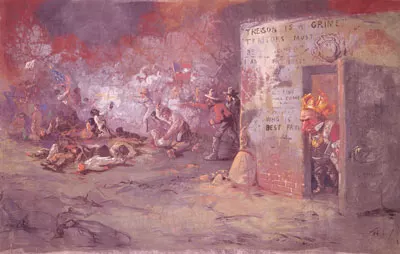
Political Cartoonist Thomas Nast drew this political cartoon, "The Massacre at New Orleans," criticizing President Andrew Johnson for his role in permitting the violence to unfold in New Orleans on July 30, 166
The Confederate military and government collapsed in the Spring and Summer of 1865, effectively ending the Civil War with the United States preserved and slavery destroyed. But the violence was far from over. White resistance to Black citizenship during Reconstruction often turned violent – as it did in New Orleans on July 30, 1866. During the war, President Abraham Lincoln had hoped that Louisiana, with a strong US military presence in Louisiana would serve as the model for readmitting states back to the United States. In 1864, the state ratified a new constitution that abolished slavery, but did not grant Black Louisianans the right to vote – something that President Lincoln began to consider as the war ended the next year.
In his last speech, delivered on April 11, 1865, Lincoln openly expressed his desire to enfranchise select freed people and emphasized that “…voters in the heretofore slave-state of Louisiana have sworn allegiance to the Union… held elections, organized a State government, adopted a free-state constitution, giving the benefit of public schools equally to black and white, and empowering the Legislature to confer the elective franchise upon the colored man.
Their Legislature has already voted to ratify the constitutional (Thirteenth) amendment recently passed by Congress, abolishing slavery throughout the nation.”1 In the crowd was John Wilkes Booth. Incensed at the thought of Black citizenship and voting, Booth assassinated President Lincoln a few days later. The violence did not stop at Ford’s Theatre.
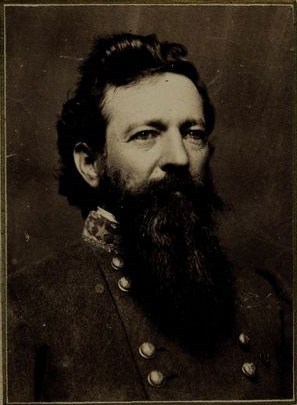
Harry T. Hays had served as a General in the Confederate Army. But in the Summer of 1866, he was the Sheriff of New Orleans, and deputized a posse of ex-Confederates to confront a citizen's convention in the city.
Gilder Lehrman Institute

This image from Harpers Weekly depicts Confederate veterans opening fire on the crowd in New Orleans. The placement of the US flag in the drawing served as a reminder to readers that some former Confederates had not yet accepted the outcome of the war.
Library of Congress
In a matter of approximately two hours, 34 African American supporters were killed, while the wounded numbered 119. Three of the delegates who had assembled in the Mechanics Institute were killed, while 17 were wounded, and approximately 200 others arrested. When the streets around the Mechanics Institute fell quiet, General Baird ordered martial law, which remained in effect into early August. On August 1, the Cleveland Daily Leader published sentiments that were shared by many other papers across the North: “Remember that this work was done by the constituted authorities of the city of New Orleans, rebels in record and in heart, but placed in power over loyal men by the policy of a renegade President. Remember that these scenes are but a prelude of what is to be… if Mr. Johnson’s policy shall be carried out.”5 Paired with news of the tragedy that occurred in Memphis months before, the New Orleans massacre contributed to major changes in Reconstruction policy. The 1866 elections saw to it that a Radical Republican majority ruled in both the House of Representatives and Senate, and ultimately contributed to the passing of the 14th and 15th Amendments. It could even be said that the violence which transpired on July 30, 1866, in a twist of irony, gave rise to several policies that would be enacted in following years, including Federal military presence in the South, temporary disenfranchisement of former Confederates, and for a population of more than four million freed people - the right to vote. 1 Lincoln, Abraham, and Scott Yenor. “Document 5: Last Public Address.” Reconstruction: Core Documents, Ashbrook Center, Ashland University, 2018, pp. 13–17. 2 O'Donovan, Susan, and Beverly Bond. “‘A History They Can Use’: The Memphis Massacre and Reconstruction's Public History Terrain.” The Journal of the Civil War Era, 10 Jan. 2018, www.journalofthecivilwarera.org/2016/08/history-can-use-memphis-massacre-reconstructions-public-history-terrain/. 3Reynolds, Donald E. “The New Orleans Riot of 1866, Reconsidered.” Louisiana History: The Journal of the Louisiana Historical Association, vol. 5, no. 1, 1964, pp. 5–27. JSTOR, www.jstor.org/stable/4230742. Accessed 30 July 2020. 4 The New-Orleans Riot. Its Official History. New York Tribune, 1866. 5 The Louisiana Convention. Cleveland Daily Leader, 1 August, 1866, p. 1. by Park Ranger Rich Condon, Reconstruction Era National Historical Park
#“An Absolute Massacre” – The New Orleans Slaughter of July 30#1866#Reconstruction Era National Historical Park#New Orleans Massacre#louisiana#Black Voting Rights#confederates#civil war.#white supremacy#Black Freedmen
7 notes
·
View notes
Text
The attempted assassination of former U.S. President Donald Trump shocked the nation.
While speaking to a rally in Butler, Pennsylvania, on the afternoon of Saturday, July 13, a 20-year-old man fired at Trump. A bullet appears to have swiped Trump’s ear, drawing blood, before the former president ducked beneath the podium, surrounded by Secret Service agents. He insisted on standing up as his security detail gave him cover, pumping his fist into the air and yelling to the crowd: “Fight!” A firefighter and rallygoer named Corey Comperatore, who dove on his family to protect them from the gunfire, did not survive.
The horrendous incident rightly earned strong condemnation from across the political spectrum. “There’s no place in America for this kind of violence,” said U.S. President Joe Biden. “It’s sick—it’s sick.”
The violence instantly became a moment for politicians and pundits to call for calm and pull back from the toxic polarization that has left Americans bitterly divided. “Violence is infecting and inflecting American political life,” an editorial in the New York Times lamented. “It’s not who we are as a nation,” Biden said in his remarks the following day.
But is it? Much of the reaction downplays just how pervasive violence has been in U.S. history. Although the ideology of American exceptionalism pushes Americans to think of their country as fundamentally different than other nations that have been wracked with these kinds of events, the truth is that the United States has a long and sordid history of people who try to solve political differences using bullets rather than ballots.
Violence is one of the reasons that the U.S. electoral system has always been extraordinarily fragile. It has taken heroic efforts to maintain the republic that Benjamin Franklin, one of the country’s founding fathers, famously warned would be necessary to care for and protect.
The common perspective that violence is somehow un-American misses a key point. The normalization of violent rhetoric in recent years is so dangerous not because it constitutes a fundamentally new turn in U.S. democracy, but because it taps into a deeply rooted history that Americans ignore at their own risk. The reality is that assassinations and assassination attempts targeting high-level officials have been taking place for decades.
The United States has sadly had many political leaders, presidents, and prominent candidates killed. The price that President Abraham Lincoln paid for trying to preserve the union and bring an end to slavery was John Wilkes Booth murdering him on April 14, 1865, in Washington, D.C. In July 1881, Charles Guiteau shot President James Garfield, who died in September. The nation had barely caught its breath before an anarchist named Leon Czolgosz killed President William McKinley in 1901. And Americans would mourn collectively after Lee Harvey Oswald assassinated President John F. Kennedy in November 1963.
The count of these four slain leaders does not include the many serious assassination attempts that failed, such as when President Franklin Roosevelt was nearly killed in February 1933 by an unemployed tradesman named Giuseppe Zangara. President Gerald Ford survived two attempts to kill him within weeks in 1975. President Ronald Reagan’s life was almost brought to an end by John Hinkley Jr. in March 1981. Like Trump, Reagan managed to manage the crisis to his benefit. Reagan and his team downplayed the severity of the wound. He and his team shared jokes to emphasize perseverance, such as his telling the surgeons: “I hope you are all Republicans.”
Candidates for the presidency have also been targets. On Oct. 14, 1912, former Republican President Teddy Roosevelt, running as a third-party candidate, was fired at by John Schrank during a campaign rally. An eyeglass case made of metal and the thick text of the copy of his speech in his pocket saved his life even though a bullet penetrated his chest. Roosevelt refused to go to the hospital and instead went on to give his talk. “I don’t know whether you fully understand that I have just been shot,” Roosevelt said, “But it takes more than that to kill a Bull Moose!”
Most baby boomers remember when Sen. Robert Kennedy, after winning the June 1968 California primary, was slain by Sirhan Sirhan at the Ambassador Hotel in Los Angeles. Four years later, Alabama Gov. George Wallace, who became infamous for his staunch opposition to racial integration, was partially paralyzed a bullet during his run for the presidency in 1972.
Violence has also afflicted Capitol Hill. The Yale University historian Joanne Freeman writes that violence in the pre-Civil War Congress was as American as apple pie. Freeman took the classic story of the pro-slavery South Carolina Rep. Preston Brooks beating Massachusetts Sen. Charles Sumner with a cane and revealed that it was not an anomaly. By the 1850s, members of the House and Senate were coming to work armed and loaded, and they frequently engaged in physical conflict on the floors of the chambers as tensions over slavery mounted. Freeman documented more than 70 acts of violence between congressmen in the tense period between 1830 and 1860.
Civilians have also deployed violence against legislators. A man named Carl Weiss took the life of Louisiana Sen. Huey Long, a potential candidate for the presidency, in 1935. On January 8, 2011, Arizona Democratic Rep. Gabrielle Giffords was badly wounded after being fired upon in Tucson; one of her staffers and five others were killed. In 2017, a 66-year-old man named James Hodgkinson gravely wounded House Majority Whip Steve Scalise during a practice for the annual congressional baseball game. Even family members can become victims, as former House Speaker Nancy Pelosi’s husband, Paul Pelosi, experienced in his home when a conspiracy theorist David DePape bludgeoned him in October 2022.
At the national level, violence has not been confined to politicians. The United States has also lost the leaders of many movements along the way. The streets of the cities were on fire after civil rights leader Martin Luther King Jr. was shot down in Memphis in April 1968; three years earlier, Malcolm X had been killed as well.
The United States has also seen immense electoral violence at the local level. The Jim Crow South was a political system where institutionalized violence was essential to the disenfranchisement of Black Americans. In states such as Mississippi, Black residents understood that they faced immense risk when they traveled to the courthouse in an attempt to register to vote. Another civil rights leader, the charismatic and inspiring NAACP field secretary Medgar Evers, was struck down outside his home on June 12, 1963. T.R. Howard, a surgeon and civil rights leader, said in his eulogy for Evers: “For 100 years, we have turned one cheek and then another. And they have continued to hit us on both cheeks, and I’m just getting tired now of hurting in silence.”
This year is also the 60th anniversary of Freedom Summer in Mississippi, where three civil rights workers—James Chaney, Mickey Schwerner, and Andrew Goodman—were murdered by the KKK and allied police officials because they were partaking in the voting rights mobilization that inspired young people around the world. And much of the country, including President Lyndon B. Johnson, was horrified a year later on March 7, 1965, now called “Bloody Sunday,” when police and white mobs brutally attacked nonviolent civil rights activists who were marching from Selma to Montgomery in support of voting rights legislation. Photographers captured the horrific images when troops fractured the skull of John Lewis, a leader from the Student Nonviolent Coordinating Committee and future member of Congress.
On Nov. 27, 1978, Dan White, a former member of the board of supervisors of San Francisco, shot and killed Mayor George Moscone and Supervisor Harvey Milk, who had become a heroic figure within the gay community. And since the tumultuous 2020 election that culminated with the attempted insurrection at the U.S. Capitol on Jan. 6, 2021, 40 percent of state legislators polled by the Brennan Center for Justice have reported receiving threats.
The United States has many wonderful characteristics, but violence is one of them as well. As the historian Richard Slotkin has written in his classic works on the subject, violent mythology has always been deeply embedded in American culture. More recently, the historian Steven Hahn has traced the powerful impact of illiberalism, which has included electoral violence, since the founding of the country.
None of this unsettling history should discount the dangers stemming from the very real uptick in violence and violent threats that government officials have faced in recent years, which have reached elected officials, judges, and even poll workers. The current atmosphere is indeed one of heightened danger. Just because conditions have been bad in the past does not provide comfort in current times.
Yet history should send a strong warning about the dangers of politicians and others who use violent rhetoric. Indeed, this warning was often made to Trump, both when he was president and after, about his willingness to incite crowds. These calls to action tap into a treacherous component of U.S. culture that is often right beneath the surface.
The attempt to kill Trump should be a chilling reminder of how easy it is for some Americans to trigger a lethal tradition. Americans have seen the ugliness too many times before to act like this doesn’t usually happen here. It does.
10 notes
·
View notes